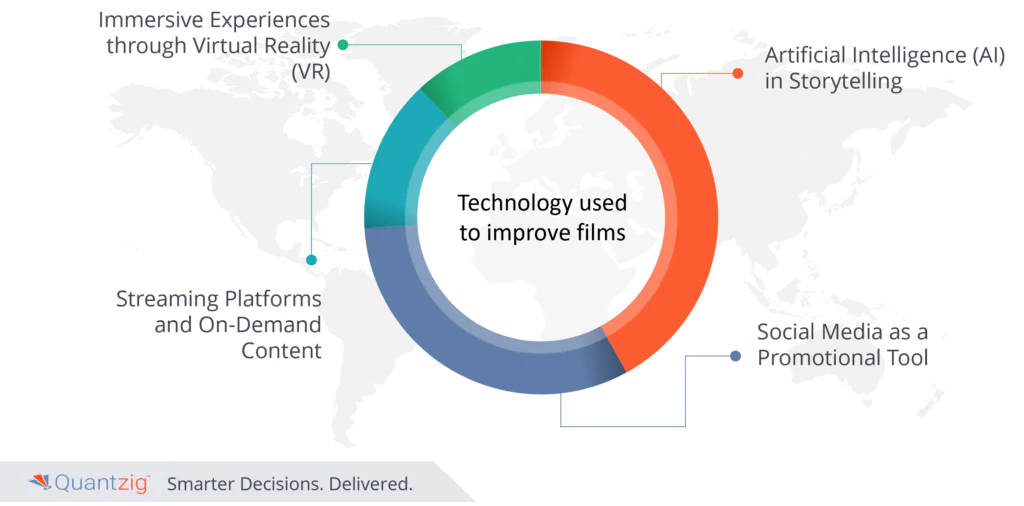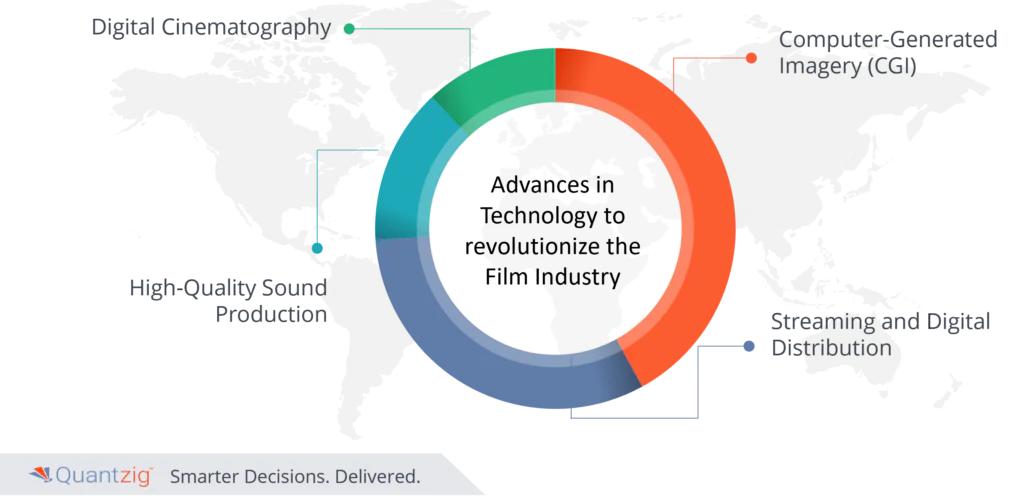In the ever-evolving landscape of the film industry, staying ahead of the curve is essential for success. In this era of digital transformation, where creativity and technology intersect, those who can harness the power of emerging media trends are poised to become the Steve Jobs of the film world. Just as Steve Jobs revolutionized the tech industry with groundbreaking innovations, filmmakers now have the opportunity to reshape the cinematic landscape.
This blog delves into four dynamic film making trends that are set to transform the way we create, consume, and distribute films. From immersive experiences in virtual reality and the impact of artificial intelligence on storytelling to the rise of streaming platforms and the role of social media in film promotion, we’ll explore how these trends are reshaping the industry and how you can leverage them to become a trailblazer in the world of cinema. Get ready to embark on a journey of cinematic innovation and discover the key to becoming a visionary in the film industry.
Book a demo to experience the meaningful insights we derive from data through our analytical tools and platform capabilities. Schedule a demo today!
Request a Free DemoTable of Contents
4 Media Analytics Trends That Will Revolutionize the Film Industry:
Lord of The Films: Virtual Reality
Movies take you to a totally different world, but with the help of virtual reality – quite literally! This is one of the popular film making trends in the industry today, which aims at creating an immersive and interactive audience experience. How cool would it be to feel that you are inside the movie right? But the use of VR technology in the film industry is still at its nascent stage as the movie makes are gradually figuring out ways to pull off a good balance of artistic talents and technical skills using virtual reality. Once this technology is perfectly put into place in the film industry, it will pave the way for an ‘out of the world’ movie viewing experience.’
Mobile Filmmaking Rises
With mobiles dominating our lives, it is not surprising that players in the film industry are venturing into mainstream mobile filmmaking. By venturing into mobile filmmaking, filmmakers get the opportunity to cut down on costs associated with the use of traditional cameras and will be able to create content on the move. Since the popularity of mobile filmmaking is growing, mobile manufacturers are rapidly developing smartphones with higher camera quality and apps that support HD video recording.
Era of “Netflix and Chill”
Media analytics trends like electronic home video or on-demand streaming services have experienced sky-rocketing popularity in the past few years. On-demand streaming services like Netflix and Amazon Prime have become so successful that they are not just broadcasting the best films and TV shows anymore but have also started producing content themselves.
Drone is in the Air
Filmmakers have been relying on drones to shoot aerial footage for years, but earlier they had some major limitations such as short battery life and inconsistent film quality due to which they took a backseat in the film industry. However, drone technology has evolved in recent times, making them an easier, cheaper, and faster technology for exceptional shots from various angles.
Get started with your complimentary trial today and delve into our platform without any obligations. Explore our wide range of customized, consumption driven analytical solutions services built across the analytical maturity levels.
Start your Free Trial TodayHow will technology be used to improve films in the future?
Technology continues to be a driving force in the evolution of the film industry, and its potential to reshape the art of filmmaking and audience engagement is nothing short of revolutionary. To become the Steve Jobs of the film industry, one must stay attuned to these four critical film making trends that are set to transform the future of cinema.

Immersive Experiences through Virtual Reality (VR): The integration of virtual reality in filmmaking is poised to transport audiences into entirely new realms of storytelling. VR allows filmmakers to create immersive, 360-degree environments, offering a level of engagement that conventional cinema cannot match. This technology enables viewers to be active participants in the narrative, blurring the lines between storytelling and interactivity. As VR hardware becomes more accessible and affordable, it’s clear that the future of film will include increasingly immersive experiences.
Artificial Intelligence (AI) in Storytelling: AI is rapidly becoming a powerful tool for filmmakers. From script analysis and character development to predicting audience preferences, AI can assist in optimizing various aspects of the creative process. Machine learning algorithms can even aid in the creation of realistic CGI characters and special effects. As AI continues to advance, it will help filmmakers streamline production and enhance storytelling in unprecedented ways.
Streaming Platforms and On-Demand Content: Traditional cinema is facing stiff competition from the rise of streaming platforms. With the convenience of on-demand access to a vast library of content, viewers now expect personalized and easily accessible entertainment. Filmmakers must adapt by creating content tailored to these platforms, giving rise to new opportunities for diverse and independent voices in the industry.
Social Media as a Promotional Tool: In the digital age, social media has become a powerful marketing tool for filmmakers. Platforms like Instagram, TikTok, and Twitter provide opportunities to engage with audiences, build anticipation, and even crowdfund projects. A strong social media presence is now a necessity for filmmakers to connect with their fanbase and promote their work effectively.
Optimizing Marketing and Box Office Predictions: Streaming companies and movie theaters benefit significantly from data analytics in marketing and promotion. By leveraging data, companies can perform detailed audience segmentation, identifying the most promising target groups for each film. Predictive models in movie analytics provide insights into potential box office predictions, allowing for strategic allocation of marketing budgets. This ensures resources are used efficiently, achieving maximum impact. Moreover, insights from data help in media consolidation activity, where integrated marketing efforts can span across various platforms, including regional sports networks. This comprehensive approach ensures cohesive and effective promotional campaigns, ultimately driving higher box office revenues and successful budget optimization.

In conclusion, the film industry’s future is intertwined with technological advancements, presenting both challenges and opportunities. Embracing these media analytics trends is the key to not only surviving but thriving in this dynamic landscape, and potentially becoming the next Steve Jobs of the film world. By staying ahead of the curve and leveraging these innovations, filmmakers can shape the future of cinema in ways once thought unimaginable.
Benefits of Cinelytic’s AI for the Film Industry
Cinelytic’s AI offers transformative benefits for the film industry or media & entertainment industry by leveraging advanced data analytics to enhance movie analytics, script development, and audience segmentation. This AI-driven approach provides precise box office predictions, enabling more effective budget optimization and strategic marketing and promotion. For streaming companies and movie theaters, Cinelytic’s tools optimize content creation and distribution, ensuring alignment with viewer preferences. Additionally, its insights facilitate media consolidation activity, integrating various segments of the media & entertainment industry including regional sports networks. Overall, Cinelytic’s AI supports more informed decision-making, improving financial performance and competitive advantage across the industry.
Advances in Technology that have Revolutionized the Film Industry:
The film industry is undergoing a remarkable transformation, driven by filmmaking innovations and emerging trends in filmmaking that redefine storytelling. Four key technological advancements are shaping the future of filmmaking, presenting opportunities for those who adapt.
In the media & entertainment industry, data analytics is revolutionizing script development and audience segmentation. By analyzing vast amounts of viewer data, studios can identify themes, genres, and narratives that resonate with specific demographics. For instance, a studio might use movie analytics to examine the success factors of past hits, refining scripts to align with these insights. This ensures the content is tailored to targeted audiences, enhancing engagement and satisfaction. Additionally, box office predictions become more accurate, allowing for precise budget optimization. Effective marketing and promotion strategies can then be developed, maximizing reach and impact. This integration of data supports overall content creation, ensuring films align with market demands and audience expectations, a testament to modern filmmaking trends and digital filmmaking trends.
Digital Cinematography:
The transition from traditional film to digital cinematography has been a game-changer. Digital cameras offer greater flexibility, cost efficiency, and the ability to shoot high-quality footage. Filmmakers can now experiment with shots and lighting in real-time, without the limitations of physical film stock.
Computer-Generated Imagery (CGI):
CGI has opened up new dimensions of creativity in filmmaking. It enables the creation of fantastical worlds, lifelike characters, and jaw-dropping special effects that were once unimaginable. This technology continues to push the boundaries of visual storytelling.
High-Quality Sound Production:
Advancements in sound technology have significantly enhanced the immersive experience of cinema. High-definition audio systems and sound design software allow filmmakers to craft intricate soundscapes that draw audiences deeper into the narrative.
Streaming and Digital Distribution:
The rise of streaming platforms and digital distribution has transformed how films are consumed. It has democratized the industry, providing a platform for indie filmmakers and a personalized viewing experience for audiences.
Moreover, the rise of AI in filmmaking trends and virtual reality in filmmaking is pushing boundaries, allowing for unique storytelling experiences. Sustainable filmmaking practices are also gaining traction, ensuring that the industry evolves responsibly. By embracing these film production trends and new technologies in filmmaking, studios can position themselves at the forefront of the film industry trends and thrive in an ever-changing landscape.
Experience the advantages firsthand by testing a customized complimentary pilot designed to address your specific requirements. Pilot studies are non-committal in nature.
Request a Free PilotConclusion
In conclusion, the four media trends discussed here are the driving forces behind a cinematic revolution. Embracing these trends is not just a choice but a necessity for aspiring filmmakers and industry veterans alike. The convergence of virtual reality, artificial intelligence, streaming platforms, and social media offers unprecedented opportunities for creativity, innovation, and audience engagement. Those who master these trends stand to become the Steve Jobs of the film industry, reshaping the art of filmmaking and storytelling. As we venture further into the digital age, the intersection of technology and cinema will continue to forge new paths, and those who lead the way will leave an indelible mark on the industry’s future.






